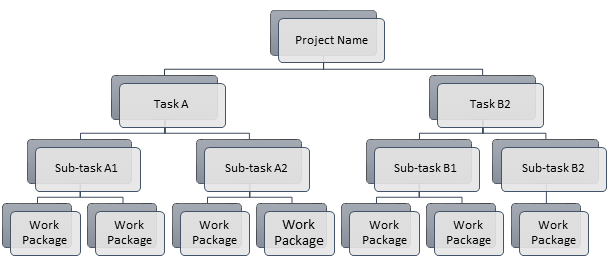
You might have seen the term come up a lot, especially when talking about a Work Breakdown Structure (WBS), and wondered to yourself what is a work package anyway? Well, a work package is a collection of similar tasks which are bundled together to create a kind of mini-project within a project. What defines a work package is the inter-relatedness of the tasks involved, as they must have elements which connect them.

A work package is generally decided on due to the following characteristics they have in common:
- Nature of work involved (e.g. marketing, programming, etc.)
- Outcomes of the tasks
- Geographical location where tasks take place
- Time when tasks will be completed
- Technology or materials that will be used
- Team leaders in charge
- Specific stakeholders
By putting related tasks together, a work package becomes an easier element to understand for the project team responsible. Team members are able to see the connection between different task strands and focus on those that apply to them. As part of a Work Breakdown Schedule, using work packages provides a greater level of clarity as each block of connected tasks can be easily visualized.
To distinguish what is a work package from an actual project in its own right, one must look at the outcomes. Each work package is only ever one element of something larger, so its outcomes will directly relate to the furtherance of the aims of the overall project. Let’s consider at an example, if adding a new feature to a technology product, like some great project management software, there may be several work packages related to its development, such as:
- Design
- Development
- Testing
- Integration
- Launch
Within each of these there will be a wide variety of different tasks but by arranging related tasks together it becomes easier to communicate with responsible teams and set milestones and deadlines to get a better idea of your project’s critical path.
Using work packages effectively means that your team shouldn’t get bogged down with information or caught up on email threads that have no relevance for their department. They also provide an easy reference point for describing a variety of metrics within the project, such as:
- Budget: Knowing how much is dedicated to each area and how well it is being adhered to
- Deadlines: How well they are being kept to and whether certain areas are causing more delays than others
- Risks: What needs to be watched for where and how likely issues are to arise
- Priority: The importance of various areas and what needs to be focused on first
- Stakeholders: Knowing who needs to be kept in the loop for different task strands
For project managers, using work packages effectively is essential as it allows them to easily differentiate and delegate necessary tasks. They also provide greater visibility for other stakeholders outside the project team, making it easier to explain budget and timeline issues from a broader perspective rather than having to go into detail on specific tasks. The most important advantage however, is that it allows a major project to be broken down into more manageable pieces so that neither you nor your team get overwhelmed by the size of the project you are undertaking.
Why it is important for project managers?
- PMI conducts a survey every year and publishes report on the state of the project management and what causes the project failure. The result is based on nearly 3000 portfolio, program and project managers across distinct collection of industries. Based on the results, only 62% of the projects met the original scope. Scope creep has increased to a great extent.
- Un-controlled or poorly managed scope can affect your project severely. It includes, missing deadline, budget overrun and even project failure.
- Let’s continue to learn more about scope and how it contributes to the success of the project.
Steps in Project Scope:
Collection of Requirements:
- For many projects, deciding what needs to be done is more difficult than getting it done. Requirement gathering and analysis is the first and most important step of the project scope management. This
- step would help the project team to understand the stakeholder’s expectations and also identifying project boundaries. Project charter will contain the high level requirements. In this requirement gathering step, project team will be involved in in-depth and detailed requirement gathering.
Methods to collect the requirement:
- Identifying all the project stakeholders is a vital step in requirement gathering. Once the stakeholders are identified, techniques like, one on one and group interview, Brainstorming, questionnaires, Prototyping (Creating an initial version of the solution using the gathered preliminary requirements) can be followed.
- Thanks to technology. It makes our job easier. There are project requirement gathering apps also available in the market which helps the project managers to save much time.
Scope creep:
- Business world is becoming very competitive day by day. An organization can survive only when it delivers an additional value to its customers. While adding value to the customers, project managers
- should understand what the scope creep for the project is and how it would impact the project. The gradual, uncontrolled increase in scope of the project is referred as scope creep.
Example of Scope creep:
- You are expected to build a 10-foot wall for the client, and client requests the team to increase the length of wall by half foot. Team does not know the consequences and think that since there is lot of
- material lying around, it’s not going to make any difference to build just half foot. As a result, they build the extra length of wall.
- It is necessary to define the project scope boundaries and not let people randomly add to the project scope without going through the change control process.
Gold plating:
- Gold plating is providing more than what the customer initially asked for. Team members individually or collaboratively add a feature or functionality, thinking that it might add value to the customer. Many
- times it happens without the knowledge of the Project Manager.
Example of Gold Plating:
- Suppose, you are doing a software program for your customer. One of the programmers comes to you and suggests an additional feature to the program. He also mentions that it won’t require any additional effort or cost to add the extra functionality and customers will love it. As project manager you also agree to implement the same.
- Though it’s good to provide additional value to the customer, the customer expectation would increase. There are chances, he would expect the same additional features in his next project as well. Hence it must be controlled and avoided by the project manager.
Define Scope:
Define scope is the process of developing a detailed description of the project and product will be created with a goal or scope. To define the scope, the following things have to be identified from the requirement documentation and other project related base documents like project charter.
- Project objectives
- Goal
- Sub-phases
- Tasks
- Resources
- Budget
- Schedule
As a project manager, understanding and being able to define project scope will give you a focus and sense of purpose when executing the project.
Scope Statement:
- While defining project scope, we should be able to come up with project scope statement which describes in detail the project’s deliverables and the work required to create those deliverables.
- Many could confuse Project scope statement with project charter. Though while creating project charters, project executives envision the scope, only project scope statement will have the detailed project’s product scope description, product acceptance criteria, assumptions, project deliverables, and project constraints.
Work Break down Structure (WBS):
- “Running a project without a WBS is like going to a strange land without a road map.”
- WBS otherwise called as decomposition technique, is all about breaking down project deliverable and project work into manageable components that can be effectively measured and supervised. This is a great tool which would help the stakeholders and the teams to understand the project precisely. It reflects the scope baseline of the entire project.
- Project manager and subject matter experts determine the main deliverable for the project based on the project scope statement. Once this is completed, with the team they start decomposing the deliverable in to small activities.
- A WBS diagram expresses the project scope in simple graphic terms. Below is an example of a simple WBS. Generally, the upper components are the deliverable and the lower level elements are the activities that create the deliverable. The lowest level in WBS is called as work package level. It is the point at which the cost and activity duration of the work can be reliably estimated and managed.
WBS Diagram Example:

5 rules of WBS:
1. 100% rule:
100% rule means that the WBS should capture all the deliverables and actives defined in the project scope.
2. Avoid Overlapping:
With the 100% rule, it is also important to ensure that there is no duplication or overlap in the different elements of scope definition of work breakdown structure.
3. Outcomes matters:
The best way to adhere to the 100% rule is to define WBS elements in terms of outcomes or results, not actions
4. Detailing rules:
Being a project manager, one should be able to decide when to stop dividing the deliverables into smaller elements. There are few “rules of thumb” used, when decomposing the deliverables and determining the duration of the activities. This is crucial to produce the expected deliverable defined by the WBS.
a. “80-hour rule”: Any activity or group of activities defined at the lowest level of WBS, should not produce any deliverable which is more than 80 hours of effort.
b. Second rule: None of the activities defined at the lowest level of the WBS should exceed the defined reporting period of the deliverables.
c. Final rule: While calculating the duration of the activities to produce a deliverable, apply “common sense”.
5. Coding WBS:
Each elements of work breakdown structure should be numbered sequentially to enable easy recognition of the element in WBS dictionary.
Validating Scope:
As per Pmbok “Validate scope is the process of formalizing acceptance of the completed project deliverables”. Validating scope includes reviewing deliverables with the customer or sponsor to ensure they are completed satisfactorily and obtain formal acceptance. To ensure the satisfactory level of the customer, frequent and planned meetings need to be organized as a part of validating scope phase.
Though the project team and quality team sends green signal for the project deliverables. It must be validated against the scope baseline to conclude whether project team has produced what was documented and planned. This is a process of acquiring formal acceptance on the completed deliverables from the customer.
Control Scope:
Control scope process monitors the status of the project and product scope and changes to the scope baseline. Controlling the project scope ensures all requested changes and recommended corrective or preventive actions are taken.
As a project manager, it is your job to keep monitoring the activities of the project and stop unwanted actions which may lead your project into problems such as scope creep and gold plating.
5 Tips for an effective project scope management.
- Involve the entire team in the process of scoping the project
- Involve all the stakeholders during the requirement gathering phase
- Confirm the deliverable frequently with the customer to avoid any last minute change
- Try to Include all the deliverable in the WBS
- being careful about the changes that were not part of the original scope and gold platting.
- Ensure that the project scope goes through Change Control process.





